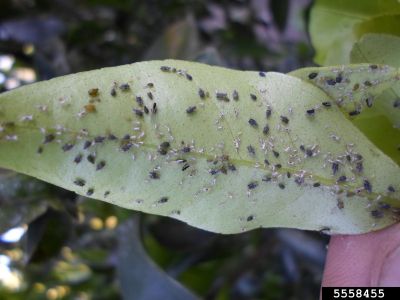Indoor Aphid Control
There are many mechanical and non-toxic methods to address your houseplant aphid problems.
Light aphid infestations
The simplest way, especially if you only have a light aphid infestation, is to simply squash the aphids with your fingers. Aphids are very soft bodied and if you only see a few of them on your plants, this is probably the easiest method. Another method that you can use for lighter infestations, especially if you don’t want to squash them with your fingers, is to wash them away with a stream of water. If you have a plant that has finer foliage, a more effective method would be to dip the plant in water. Choose a sink, bucket or other container that is large enough to accommodate the plant. You only want to dip the stems and leaves of the plant into the water and not the soil. Simply turn the plant upside down and secure the soil from falling out using newspaper or even a cardboard disk. Swish the plant around until the aphids are dislodged.
Heavier indoor aphid problems
If you have a larger infestation, you may want to purchase either an insecticidal soap or neem oil. Neem oil is derived from the neem tree and is organic. These are safe options and non-toxic. For more severe infestations, you may want to choose a product that contains pyrethrin. Pyrethrin is derived from the flowers of a certain daisy. It is fast acting and has low toxicity. Whatever product you purchase, be sure to follow the instructions on the label to ensure the best result and allow for safe use. If you want to make your own insecticidal spray, you can easily do so by mixing about 1 to 2 teaspoons of a mild dish detergent into one gallon of water. Then simply spray your plants and take special care to also cover the undersides of the leaves. Whatever liquid soap you use, choose one that has no dyes and fragrances if possible. The key to managing aphids inside is early detection. The sooner you find the issue, the easier it will be to eliminate them.
